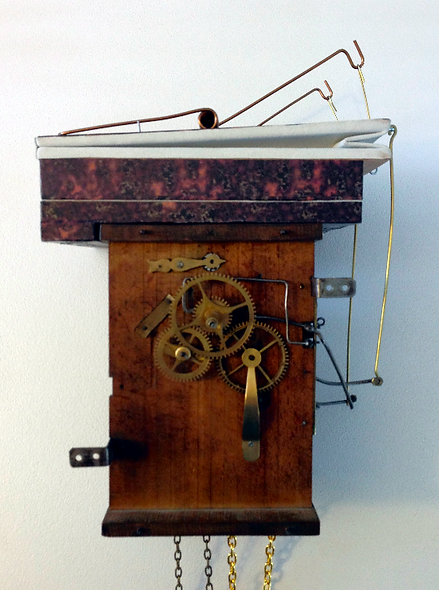
BLACK FOREST CLOCK COLLECTORS
WEBSITE AND FORUM
The History of Black Forest Clocks


The History of Black Forest Clocks

Black Forest clock production started in the mid of the 17th century as part of a in-house cottage industry for farmers to supplement their income during the long winters. The first series of clocks were for practical use and in simple design. Popularity of clocks from Black Forest grew and plates and dial face became more sophisticated.
It is said that at the beginning Black Forest clocks copied Bohemian style. Black Forest clocks gained reputation, especially the famous cuckoo clocks, which were developed in their typical style in 1854. For a long time, the cuckoo clock was attributed to Franz Anton Ketterer, a clockmaker of some repute from the Black Forest village of Schönwald. It was believed that Ketterer created the cuckoo in the 1730s, inspired by the bellows of church organs to adapt the technology in lieu of the chimes then typically used in clocks.
This oft-cited theory first emerged in a relatively popular 1979 self-published book The Black Forest Cuckoo Clock. For such an iconic timepiece, there is surprisingly little written about the cuckoo clock, but, as recently noted by the National Association of Watch & Clock Collectors, modern scholarship does not support the Ketterer theory.
While the full origins of the cuckoo clock remain unknown, evidence dates similar, though more primitive, objects to at least the mid 17th century – around 100 years before Ketterer’s supposed invention. In any case, the familiar cuckoo clock that we know and love today, the clock that hangs in our grandparents’ houses,
was certainly developed and refined by the talented craftsman and clockmakers of the Black Forest.
In traditional cuckoo clocks, the “coo coo” sound is derived from a system of bellows pushing air through two wooden whistles to recreate the distinctive two-note call of the common cuckoo. The gears of these traditional cuckoo clocks are regulated by a pendulum and system of two or three weights, traditionally shaped like pinecones, that steadily drop over a period of one day or eight days, depending on the model of the clock. One weight, along with the pendulum, is dedicated to keeping the clock gears running while the other weight controls the avian automoton.
Clocks that play music in addition to chirping will have a third weight. After a century of development that saw wood replaced with brass and metal, two distinct styles of cuckoo clock emerged from the Black Forest to dominate the market: The ornamented, house-like “Bahnhäusleuhr” or “railroad house” and the Jagdstück” or “Hunt piece” or “traditional style” clock, which features elaborate, decorative hand carved nature scenes adorning a simple encasement.
Two early examples of Black Forest Clocks
Rope drive Shield clock and a Shield flute clock


"Click on the video below to see the clock the movement belongs to and to also hear it play"
"Click on the video below to see the clock the movement belongs to and to also hear it play"
Johann Baptist Beha

Johann Baptist Beha (1815 - 1898) was a prestigious Black Forest clockmaker born in Oberbränd (Eisenbach). He was trained by his father, the master clockmaker Vinzenz Beha (1764-1868), in his workshop where he built around 365 clocks between 1839 and 1845. At that time V. Beha was already known for the quality of his clocks, he made the so-called Shield cuckoo clocks.
In 1845 Johann B. Beha founded his own clockshop in Eisenbach, beginning the manufacturing of his celebrated clocks.
A few examples of
Johann Baptist Beha clock movements





Emilian Wehrle

Emilian Wehrle (1832 – 1896, born in Schönenbach (Furtwangen), was a reputed Black Forest clockmaker famous for his high-quality musical clocks. These musical clocks included the trumpeter clock, flute clock, singing bird clock, and rooster clock. These timepieces call the hour with the sound of a trumpeter, flute, bird and rooster respectively. He was also a maker of cuckoo clocks, but these were not the primary focus of the firm.
A few examples of EmilianWehrle
Musical Clock Movements
"Click on the video below to see the clock the movement belongs to and to also hear it play"


"Click on the video below to see the clock the movement belongs to and to also hear it play"

"Click on the video below to see the clock the movement belongs to and to also hear it play"

"Click on the video below to see the clock the movement belongs to and to also hear it play"
A few examples of EmilianWehrle figures









Jacob Bäuerle

Jacob Bäuerle Trumpeter Clock

Jakob Bäuerle of Furtwangen Germany had filled the first patent that combined a mechanism that produces a trumpeters call with a clock, it is estimated that he produced the first clock of this type in the year 1857. As shown in the photo below the very early movements were constructed of wood and had several bellows to provide the air for the reeds to make the notes.
The example below has three horns to sound the notes supported by three bellows that provide the air to the reeds.
Below is a example of
Jacob Bäuerle clock and movement






© 2014 Created by Fox and Associates Consulting Inc.








